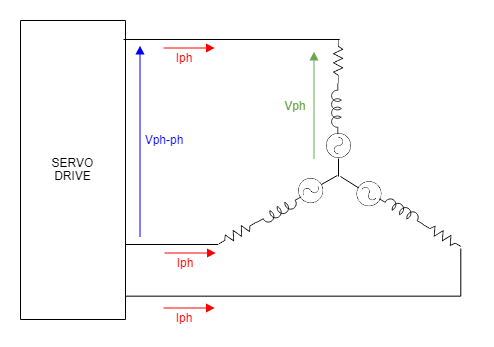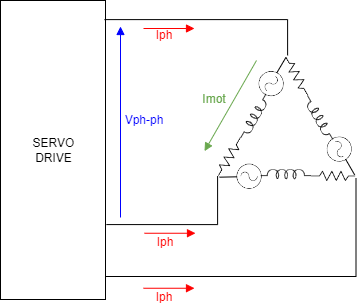How to calculate the output power of a Servo Drive
Maximum continuous output power
The maximum continuous output power than can provide a Novanta Motion Drive is calculated as it follows .
where :
is the maximum DC-bus voltage,
is the maximum continuous phase current, and
is the maximum DC Bus voltage utilization (pu), which depends on the switching frequency.
As an example, consider an Everest S XCR Servo Drive (EVS-XCR-E or EVS-XCR-C). According to the Product Description, the main parameters to calculate its maximum output power are:
Maximum absolute DC bus supply voltage (continuous): 80 V
Maximum continuous phase current = 45 A
Maximum DC Bus voltage utilization at 10kHz = 99.73% → 0.9973 pu
From these parameters we can calculate the maximum continuous output power of the Servo Drive as .
Power justification in a three-phase motor
Y-wired motor
The following diagram shows the electrical model of a Y-wired BLDC or PMSM motor:
The power in any motor can be calculated as the sum of each phase power (product of RMS current and RMS voltage). In the case of a phase-balanced motor: .
In a Y-connected motor, the phase voltage () is defined as:
,
where is the phase-to-phase voltage (difference between two output terminals of the drive).
The amplitude of the drive output phase-to-phase voltage can be defined as follows:,
where
is the DC-bus voltage of the Servo drive,
and
is the modulation index (ratio of the output voltage respect DC-bus voltage). The maximum modulation index provided by an Novanta Motion Servo Drive is defined as "Maximum Bus Voltage utilization" on the product manuals. Thanks to the use of Space Vector Modulation (SVM), this value can be close to the unit.
Summarizing, the power delivered to the motor can be defined as:
Note that the power is calculated from RMS values, while and
are expressed in amplitude of a sinusoidal. For this reason, the values are divided by
.
Δ-wired motor
From the point of view of a Servo Drive, the power provided to a Δ-wired motor or a Y-wired motor is exactly the same. However, the voltage and current values are shared different within the phases:
In a Δ-wired motor:
The motor current (
) is not the current seen at the Servo Drive. On the contrary, it is defined as:
Therefore, the total power in a Δ-wired motor results as:
Which, from the point of view of a Servo Drive, it is equivalent than for a Y-wired motor.


